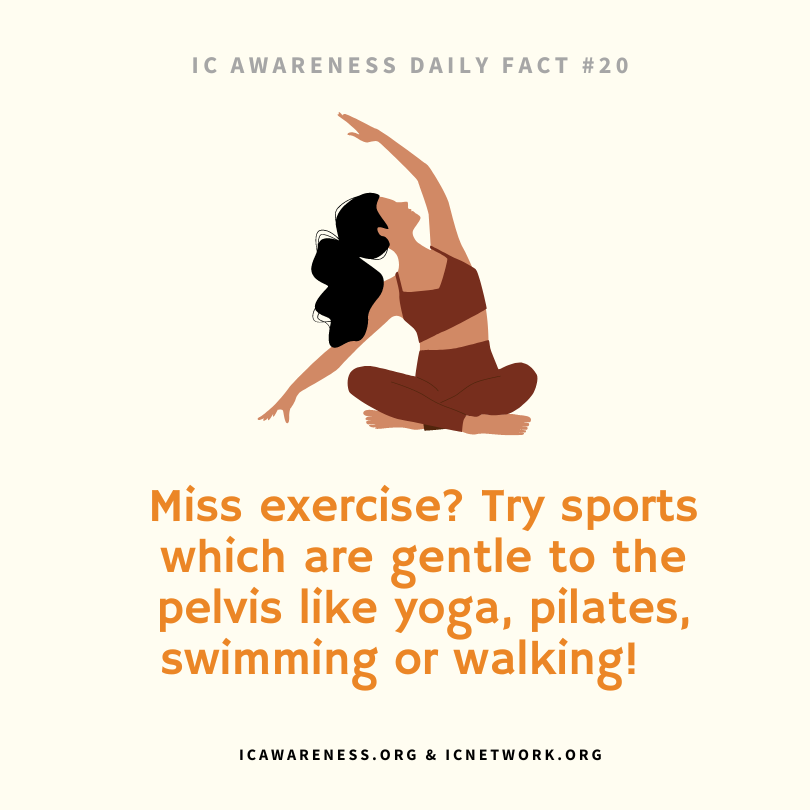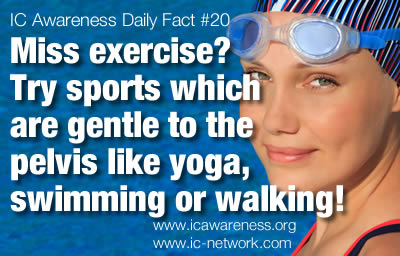
The question that many pain patients face when contemplating exercise is “will it help or hurt?” The evidence is overwhelming in favor of the former. Exercise can lift the spirits, alleviate depression and trigger the release of our bodies natural pain killers, endorphins. Many patients feel that regular exercise helps relieve symptoms thus requiring the use of fewer medications. Exercise can help increase blood flow to the pelvis, thus supporting the delivery of oxygen and other key nutrients to the pelvic organs and muscles. Regular exercise helps to decrease body weight. Perhaps most importantly, exercise can help strengthen (or relax) the pelvic floor muscles.
For the hard core athlete, a diagnosis of IC and/or pelvic pain creates great tension and confusion. I exercise for the joy of it. I love the way that I feel and the routine of going to the gym several days a week, doing distance swimming, rowing and weight lifting. Even after my diagnosis, I aggressively worked out to the frustration of my family who could clearly see that my pain was worse afterwards. I, on the other hand, was enjoying my adrenaline high.
It took a year before I finally accepted that my routine was not helping. It was when an IC support group leader reminded me that pain is a symptom that suggests that we should, perhaps, slow down that the light dawned. I had never, up to that point, believed that I was hurt nor had I given myself permission to slow down. When I actually stopped working out for a few months, I gave my body time to catch up. I started listening more closely, modifying my workouts accordingly. It didn’t take long before I could enjoy my sports again!
When you are in pain and suffering, it’s important to be respectful of that pain as an indicator that you are, indeed, hurt. Workouts must be modified accordingly and, on some days, may consist of a simple walk around the block. But, on those days when you’re feeling great, I encourage you to enjoy sports! We suggest trying exercise programs have been created for patients struggling with pelvic pain.
Do’s & Don’ts
- DON’T force yourself through pain. – If you’re in a flare, don’t force a workout. A quiet walk up and down the street can lift your spirit and mobilize your body’s natural pain fighters, aka endorphins.
- DON’T continue an exercise that is provoking pain and/or discomfort in your pelvis area. – If it hurts, stop it.
- DON’T focus on one exercise for long periods of time. To avoid building muscle tension in the pelvis, upper legs and lower back, balance your workouts accordingly, focusing on aerobic and strength conditioning
- DON’T sit for long hours on hard bicycle seat – Bicycle seats are notorious for causing pelvic floor muscle and nerve discomfort, including numbness, tingling and pain.
- DO modified interval training. – Try five minute intervals using the treadmill, rower and recumbent bicycle.
- DO resistance & strength training – Even if your pelvis is tender, don’t let that keep you from working on your legs, arms independently
- DO give yourself permission to slow down – Be gentle, especially if you’re feeling pain and discomfort. Stop any exercise that is provoking pain
- DO ask questions about exercise in the ICN support forum
Exercise Ideas
Look for activities which have a smoother motion and keep the hips level with minimal jarring to the bladder and/or pelvis! Rowing, for example, is a great exercise as it puts no pressure on the crotch, does not traumatize the pelvic floor muscles and provides a great aerobic workout using both your arms and legs. Running, on the other hand, can traumatize the bladder and pelvic area through repeated impacts.
Start slowly with small intervals. If you’re in a severe IC flare, for example, pick some gentle movements that won’t traumatize your bladder. How about using some hand weights, even cans of soup, to do some arm lifts and bicep curls. When you’re ready to walk, pick a short distance close to home so that you can easily return if necessary. Some patients love walking in shopping malls or local parks with restrooms. If you can afford a membership to a gym, such as Everyday Fitness, you won’t regret the easy access to machines, professionals and, of course, clean restrooms!
Before you begin any exercise program, it is important that you talk to your doctor about the type of exercise that is most appropriate for you – he or she may refer you to a physical therapist that can help you design a personalized exercise program depending upon the health of your pelvic floor.
Your goal? Thirty minutes a day of something that supports muscle and cardiovascular health!
- Walking – Smooth fast walking keeps your hips level yet gives you a great aerobic workout.
- Elliptical Machine – Keeps hips more level than stairmaster.
- Recumbent Bike – Avoids pressure on the pelvic floor and pudendal nerve.
- Rowing – Provides great exercise of all limbs while isolating the pelvis
- Stretch classes – Helps reduce chronic muscle tension and restores healthy blood flow
- Gentle Yoga – A popular favorite, if done without stressing the pelvic floor.
- Gentle Weights – Please avoid the machine that drives your knees in and out.
- Swimming – Pool chemicals are the biggest barrier here. Try to find a pool that doesn’t chlorine. Always remove your suit and shower immediately after leaving the pool.
- Golf – Hitting balls at the course, playing 9 holes or even miniature golf!
- Bowling
- Racquet sports
Updated: September 20, 2023 – JHO
Created: September 11-. 2014 – JHO
Tik Tok
@icnetworkjill IC Awareness Month Daily Fact 20 – don’t let IC stop you from exercising! #ic #ictik #pelvicpain #racismawareness ♬ original sound – IC Network
Past Images

